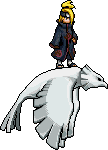Nama Ikan: Piranha Merah
Nama Latin: Pygocentrus nattereri
Nama Umum: Red-Belly Piranha, Red-bellied Piranha
Kelas: Actinopterygii
Ordo: Characidae
Family: Serrasalmidae
Red Piranha is a species of piranha family. Red Piranha live in the Amazon basin, the river on the northeast coast of Brazil, and Paraguay river basin, Parana and Essequibo ¡. Red Piranha has a reputation as a freshwater fish of the most feared in the world. Red Piranha has a series of razor sharp teeth that can strip the flesh of prey or carrion animals. As the name suggests, Red Piranha has a red belly when mature, while the Red Piranha is still small silvery with dark spots. Red Piranha can grow up to 33 cm with a weight of 3.5 kg.
Red Piranha eating fish, insects, worms, and crustaceans but sometimes also the Red Piranha eating a large animal. Red Piranha usually eat together in a large group at sunrise and will sink. Red Piranha locate the prey of smell and movement by using a series of sensors that exist on the lower body, called the lateral line system. This enables the Red Piranha to find prey in murky waters. Red Piranha has a series of conical teeth for tearing its prey. Large flock of Red Piranha sometimes dealing with large animals, such as the anaconda, Kaiman, birds and other terrestrial animals, skinning his clean-up in just a few minutes
Nama Latin: Pygocentrus nattereri
Nama Umum: Red-Belly Piranha, Red-bellied Piranha
Kelas: Actinopterygii
Ordo: Characidae
Family: Serrasalmidae
Red Piranha is a species of piranha family. Red Piranha live in the Amazon basin, the river on the northeast coast of Brazil, and Paraguay river basin, Parana and Essequibo ¡. Red Piranha has a reputation as a freshwater fish of the most feared in the world. Red Piranha has a series of razor sharp teeth that can strip the flesh of prey or carrion animals. As the name suggests, Red Piranha has a red belly when mature, while the Red Piranha is still small silvery with dark spots. Red Piranha can grow up to 33 cm with a weight of 3.5 kg.
Red Piranha eating fish, insects, worms, and crustaceans but sometimes also the Red Piranha eating a large animal. Red Piranha usually eat together in a large group at sunrise and will sink. Red Piranha locate the prey of smell and movement by using a series of sensors that exist on the lower body, called the lateral line system. This enables the Red Piranha to find prey in murky waters. Red Piranha has a series of conical teeth for tearing its prey. Large flock of Red Piranha sometimes dealing with large animals, such as the anaconda, Kaiman, birds and other terrestrial animals, skinning his clean-up in just a few minutes





















